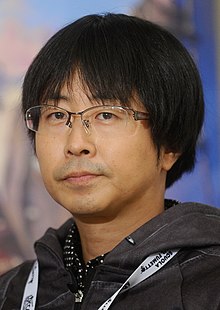Usamaru Furuya
Usamaru Furuya ( Japanese 古屋 兎 丸 , Furuya Usamaru ; born January 25, 1968 in Tokyo , Japan ) is a Japanese manga artist .
Furuya, whose dream job was a manga artist as a child, studied contemporary art at the Tama Art University. He made his debut as a professional draftsman in 1994 in the alternative manga magazine Garo , for which Kiriko Nananan also worked. He also worked as an art teacher at a high school and was briefly involved in Butoh dance theaters. His debut work Palepoli caused a sensation due to its strange humor and special painting techniques. Short Cuts , a morbid Yonkoma series with Kogals as the main characters in most of the stories, appeared in Young Sunday from 1998 , a magazine that, unlike Garo, is published by a large publisher and has a large circulation. This was followed by Marie no Kanaderu Ongaku , which is about a young person who is in love with the almighty goddess Marie, for the Comic Birz magazine and The Suicide Club about mass suicide among Japanese high school women. The suicide club was created parallel to the film of the same name, but tells a different story and, like Marie no Kanaderu Ongaku, was translated into French. A German translation was published in 2006 by Schreiber & Leser . In addition to these longer works, Furuya has also drawn several short stories, for example for the annual magazine Comic Cue , which Hisashi Eguchi founded in 1995.
Similar to Short Cuts , his manga π was published in a high-circulation Seinen magazine, Big Comic Spirits . In it he tells of a high school student who is looking for the most beautiful female breast. Furuyas Happiness was published from 2004 to 2005 in two parts in individual chapters in the alternative magazine Ikki and published in 2006 by Shogakukan as a paperback.
"As a mangaka with a tremendously rich palette of expressions, covering everything from humor to doomsday mood, Furuya publishes in a wide variety of forums, in underground magazines as well as in established manga magazines."
Works (selection)
- Palepoli , 1994-1995
- Short Cuts (シ ョ ー ト カ ッ ツ ), 1998–1999
- Marie no Kanaderu Ongaku (Marie の 奏 で る 音 楽 ), 2000–2001
- The Suicide Club (自殺 サ ー ク ル , Jisatsu Circle ), 2002
- π , 2003-2005
- Happiness ( ハ ピ ネ ス ), 2004–2005
- Raichi Hikari Club ( ラ イ チ ☆ 光 ク ラ ブ ), 2005–2006
- Shōnen Shōjo Hyōryōki ( 少年 少女 漂流 記 ), 2006, after Otsuichi
- Tokyo Inferno (彼女 を 守 る 51 の 方法 , Kanojo o Mamoru 51 no Hōhō ), 2006–2007
- Innosen Shōnen Jūjigun ( イ ン ノ サ ン 少年 十字 軍 ), since 2007
- Genkaku Picasso ( 幻 覚 ピ カ ソ ), since 2008
- Ningen Shikkaku ( 人間 失 格 ), since 2009, after Osamu Dazai
literature
- Masanao Amano, Julius Wiedermann (eds.): Usamaru Furuya . In: Manga Design . Taschen Verlag, 2004, ISBN 3-8228-2591-3 , pp. 436-441
Web links
- Usumaru Furuya website
- Biography at STRAPAZIN
- Interview with Usumaru Furuya (Japanese)
- Usamaru Furuya in the Comiclopedia (English)
| personal data | |
|---|---|
| SURNAME | Furuya, Usamaru |
| ALTERNATIVE NAMES | 古屋 兎 丸 (Japanese) |
| BRIEF DESCRIPTION | Japanese manga artist |
| DATE OF BIRTH | January 25, 1968 |
| PLACE OF BIRTH | Tokyo , Japan |
